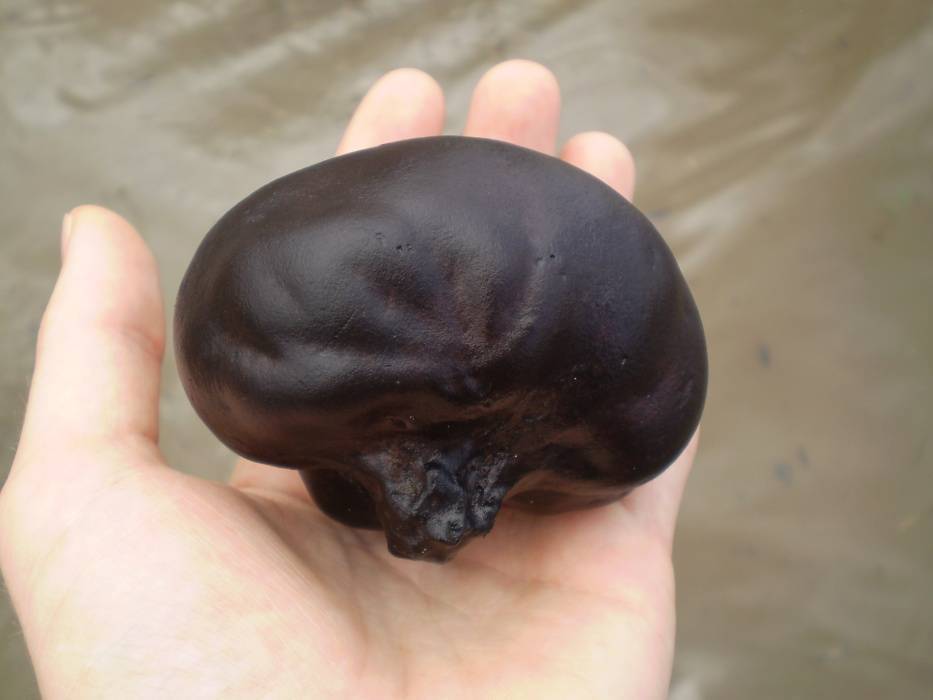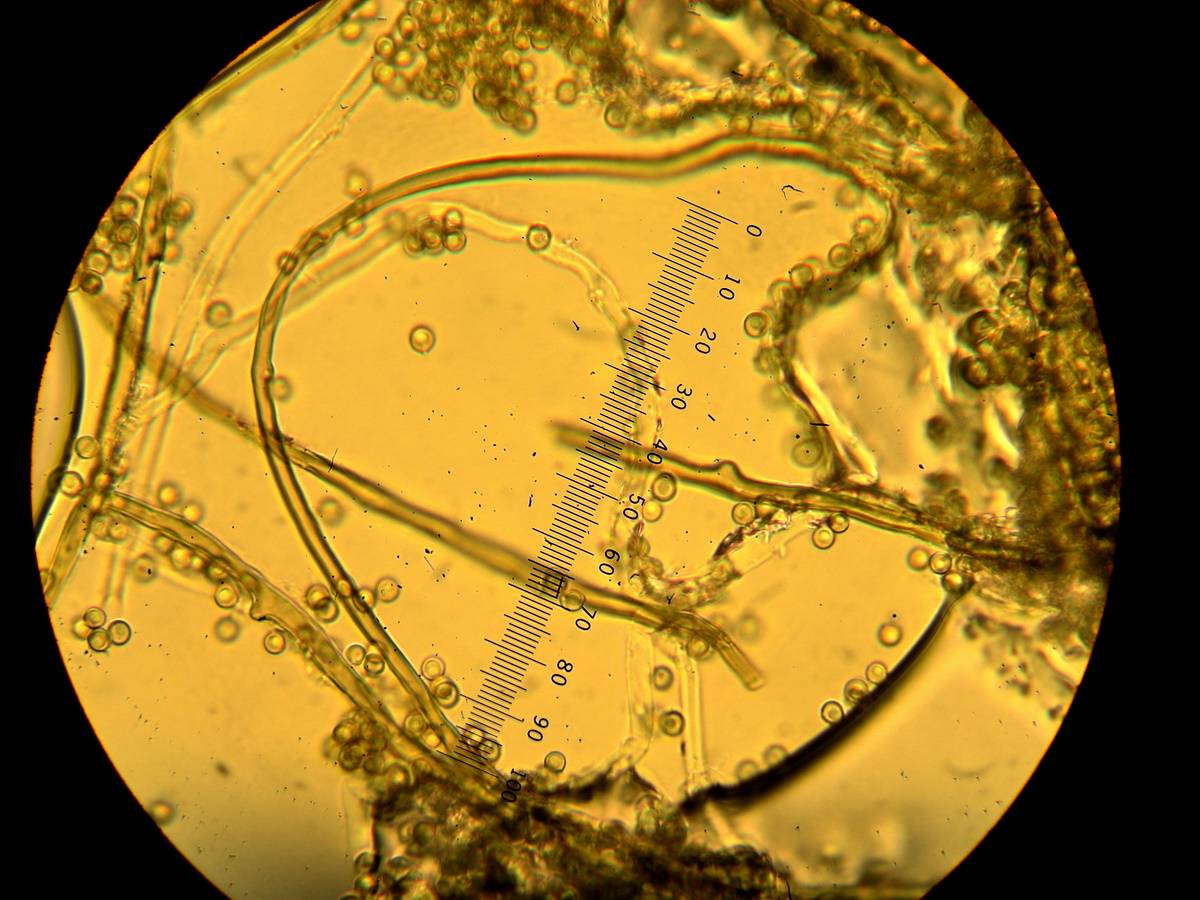|
Mycenastrum
''Mycenastrum'' is a fungal genus in the family Agaricaceae. The genus is monotypic, containing one widely distributed species, ''Mycenastrum corium'', known by various common names: the giant pasture puffball, leathery puffball, or tough puffball. The roughly spherical to turnip-shaped puffball-like fruit bodies grow to a diameter of . Initially covered by a thick, felted, whitish layer, the puffballs develop a characteristic checkered skin (peridium) in age. When the internal spore mass, the gleba, is firm and white, the puffball is edible, although some individuals may suffer mild gastrointestinal symptoms after eating it. As the spores mature, the gleba turns first yellowish then purplish brown. Spores are released when the peridium eventually splits open into irregularly shaped sections. Microscopically, the gleba consists of spherical, dark brown spores with rounded bumps on their surfaces, and a capillitium—intricately branched fibers that form long thorn-like spines. The ... [...More Info...] [...Related Items...] OR: [Wikipedia] [Google] [Baidu] |
Nicaise Auguste Desvaux
Nicaise Auguste Desvaux (28 August 1784 – 12 July 1856) was a French botanist. From 1816 he taught classes in Angers, where from 1817 to 1838 he served as director of its botanical garden. He described the botanical genera ''Neslia'', ''Mycenastrum'', ''Rostkovia'' and ''Didymoglossum''. The genus '' Desvauxia'' is named in his honor. Works *''Journal de Botanique, appliquée à l'Agriculture, à la Pharmacie, à la Médecine et aux Arts'' (1813-1815, 4 volumes). *''Observations sur les plantes des environs d'Angers'' (1818). *''Flore de l'Anjou ou exposition méthodique des plantes du département de Maine et Loire et de l’ancien Anjou'' (1827). *''Prodrome de la famille des fougères'' (1827). *''Sur le genre Mycenastrum'', In: Annales des Sciences Naturelles Botanique, Série 2 17: 143- 47(1842). [...More Info...] [...Related Items...] OR: [Wikipedia] [Google] [Baidu] |
Capillitium
Capillitium (pl. capillitia) is a mass of sterile fibers within a fruit body interspersed among spores. It is found in Mycetozoa (slime molds) and gasteroid fungi of the fungal subdivision Agaricomycotina The subdivision Agaricomycotina, also known as the hymenomycetes, is one of three taxa of the fungal division Basidiomycota (fungi bearing spores on basidia). The Agaricomycotina contain some 20,000 species, and about 98% of these are in the cla .... In the fungi, the form of the capillitia, including shape, size, branching patterns, presence or absence of slits or pores, thickness of the walls, and color, are features that can be used to identify certain species or genera. References {{Reflist, refs= {{cite book , title=Poisonous Mushrooms of the northern United States and Canada , vauthors=Ammirati J, Traquair JA, Horgen PA , year=1985 , publisher=Fitzhenry & Whiteside in cooperation with Agriculture Canada , location=Markham, Ontario , isbn=978-0889029774 , page=30, 376 , ... [...More Info...] [...Related Items...] OR: [Wikipedia] [Google] [Baidu] |
Lycoperdaceae
The Agaricaceae are a family of basidiomycete fungi and include the genus ''Agaricus'', as well as basidiomycetes previously classified in the families Tulostomataceae, Lepiotaceae, and Lycoperdaceae. Taxonomy The family Agaricaceae was published by French botanist François Fulgis Chevallier in 1826. It is named after the type genus ''Agaricus'', originally circumscribed by Carl Linnaeus in his 1753 work ''Species Plantarum''. In his authoritative 1986 classification of the Agaricales, Rolf Singer divided the Agaricaceae into four tribes distinguished largely by spore color: ''Leucocoprineae'', ''Agariceae'', ''Lepioteae'', and ''Cystodermateae''. Genera once classified in the families Tulostomataceae, Battarreaceae, Lycoperdaceae, and Mycenastraceae have since been moved to the Agaricaceae based on molecular phylogenetics studies. According to a standard reference text, the Agaricaceae contains 85 genera and 1340 species. Description Agaricaceae species use a wide variety of ... [...More Info...] [...Related Items...] OR: [Wikipedia] [Google] [Baidu] |
Sister Group
In phylogenetics, a sister group or sister taxon, also called an adelphotaxon, comprises the closest relative(s) of another given unit in an evolutionary tree. Definition The expression is most easily illustrated by a cladogram: Taxon A and taxon B are sister groups to each other. Taxa A and B, together with any other extant or extinct descendants of their most recent common ancestor (MRCA), form a monophyletic group, the clade AB. Clade AB and taxon C are also sister groups. Taxa A, B, and C, together with all other descendants of their MRCA form the clade ABC. The whole clade ABC is itself a subtree of a larger tree which offers yet more sister group relationships, both among the leaves and among larger, more deeply rooted clades. The tree structure shown connects through its root to the rest of the universal tree of life. In cladistic standards, taxa A, B, and C may represent specimens, species, genera, or any other taxonomic units. If A and B are at the same taxonomic ... [...More Info...] [...Related Items...] OR: [Wikipedia] [Google] [Baidu] |
Cladistic
Cladistics (; ) is an approach to biological classification in which organisms are categorized in groups (" clades") based on hypotheses of most recent common ancestry. The evidence for hypothesized relationships is typically shared derived characteristics ( synapomorphies'')'' that are not present in more distant groups and ancestors. However, from an empirical perspective, common ancestors are inferences based on a cladistic hypothesis of relationships of taxa whose character states can be observed. Theoretically, a last common ancestor and all its descendants constitute a (minimal) clade. Importantly, all descendants stay in their overarching ancestral clade. For example, if the terms ''worms'' or ''fishes'' were used within a ''strict'' cladistic framework, these terms would include humans. Many of these terms are normally used paraphyletically, outside of cladistics, e.g. as a 'grade', which are fruitless to precisely delineate, especially when including extinct species. R ... [...More Info...] [...Related Items...] OR: [Wikipedia] [Google] [Baidu] |
Lycoperdales
The Lycoperdales are a now outdated order of fungi. The order included some well-known types such as the giant puffball, the earthstars, and other tuberous fungi. They were defined as having epigeous basidiomes, a hymenium present, one to three layers in the peridium (outer wall), powdery gleba, and brown spores. The restructuring of fungal taxonomy brought about by molecular phylogeny has divided this order. Most of its members have been placed in family Agaricaceae of order Agaricales, while the earthstars are now in Geastrales, and similar species now occupy the order Phallales. Lycoperdales were distinguished by their globose or subglobose fruiting body having a gleba that is powdery at maturity, and generally supported by sterile tissue. Example genuses include Lycoperdon, Bovista, and Calvatia ''Calvatia'' is a genus of puffball mushrooms that includes the spectacular giant puffball ''C. gigantea''. It was formerly classified within the now-obsolete order Lycop ... [...More Info...] [...Related Items...] OR: [Wikipedia] [Google] [Baidu] |
Molecular Phylogenetics
Molecular phylogenetics () is the branch of phylogeny that analyzes genetic, hereditary molecular differences, predominantly in DNA sequences, to gain information on an organism's evolutionary relationships. From these analyses, it is possible to determine the processes by which diversity among species has been achieved. The result of a molecular phylogenetic analysis is expressed in a phylogenetic tree. Molecular phylogenetics is one aspect of molecular systematics, a broader term that also includes the use of molecular data in taxonomy and biogeography. Molecular phylogenetics and molecular evolution correlate. Molecular evolution is the process of selective changes (mutations) at a molecular level (genes, proteins, etc.) throughout various branches in the tree of life (evolution). Molecular phylogenetics makes inferences of the evolutionary relationships that arise due to molecular evolution and results in the construction of a phylogenetic tree. History The theoretical frame ... [...More Info...] [...Related Items...] OR: [Wikipedia] [Google] [Baidu] |
Sanford Myron Zeller
Sanford Myron Zeller (19 October 1885 – 4 November 1948) was an American mycologist. Born in Coldwater, Michigan, Zeller was educated at Lawrence College in Wisconsin, then Greenville College in Illinois, from which he received a Bachelor of Science degree in 1909. He earned his doctorate in botany in 1917 at Washington University in St. Louis, and two years later started a 29-year stint as a plant pathologist and professor at the Oregon Agricultural Experiment Station in Corvallis, Oregon. He published over 150 scientific papers during his career. Zeller specialized in the gasteroid fungi. Independently, he described 3 orders, 9 families, 7 genera, 81 species, and published 29 new names and combinations, as well as 3 genera, 62 species, and 59 combinations in collaborations with other scientists. Zeller was the associate editor of the scientific journal ''Phytopathology'' from 1924 to 1930. Eponymous taxa *'' Aleurodiscus zelleri'' Burt 1926 *'' Armillaria zelleri'' D.E. St ... [...More Info...] [...Related Items...] OR: [Wikipedia] [Google] [Baidu] |
Synonym (biology)
The Botanical and Zoological Codes of nomenclature treat the concept of synonymy differently. * In botanical nomenclature, a synonym is a scientific name that applies to a taxon that (now) goes by a different scientific name. For example, Linnaeus was the first to give a scientific name (under the currently used system of scientific nomenclature) to the Norway spruce, which he called ''Pinus abies''. This name is no longer in use, so it is now a synonym of the current scientific name, ''Picea abies''. * In zoology, moving a species from one genus to another results in a different binomen, but the name is considered an alternative combination rather than a synonym. The concept of synonymy in zoology is reserved for two names at the same rank that refers to a taxon at that rank - for example, the name ''Papilio prorsa'' Linnaeus, 1758 is a junior synonym of ''Papilio levana'' Linnaeus, 1758, being names for different seasonal forms of the species now referred to as ''Araschnia leva ... [...More Info...] [...Related Items...] OR: [Wikipedia] [Google] [Baidu] |
Rouen
Rouen (, ; or ) is a city on the River Seine in northern France. It is the prefecture of the Regions of France, region of Normandy (administrative region), Normandy and the Departments of France, department of Seine-Maritime. Formerly one of the largest and most prosperous cities of Middle Ages, medieval Europe, the population of the metropolitan area (french: functional area (France), aire d'attraction) is 702,945 (2018). People from Rouen are known as ''Rouennais''. Rouen was the seat of the Exchequer of Normandy during the Middle Ages. It was one of the capitals of the Anglo-Normans, Anglo-Norman dynasties, which ruled both England and large parts of modern France from the 11th to the 15th centuries. From the 13th century onwards, the city experienced a remarkable economic boom, thanks in particular to the development of textile factories and river trade. Claimed by both the French and the English during the Hundred Years' War, it was on its soil that Joan of Arc was tried ... [...More Info...] [...Related Items...] OR: [Wikipedia] [Google] [Baidu] |
Alfalfa
Alfalfa () (''Medicago sativa''), also called lucerne, is a perennial flowering plant in the legume family Fabaceae. It is cultivated as an important forage crop in many countries around the world. It is used for grazing, hay, and silage, as well as a green manure and cover crop. The name alfalfa is used in North America. The name lucerne is the more commonly used name in the United Kingdom, South Africa, Australia, and New Zealand. The plant superficially resembles clover (a cousin in the same family), especially while young, when trifoliate leaves comprising round leaflets predominate. Later in maturity, leaflets are elongated. It has clusters of small purple flowers followed by fruits spiralled in 2 to 3 turns containing 10–20 seeds. Alfalfa is native to warmer temperate climates. It has been cultivated as livestock fodder since at least the era of the ancient Greeks and Romans. Etymology The word ''alfalfa'' is a Spanish modification of the Arabic word ''al-faṣfaṠ... [...More Info...] [...Related Items...] OR: [Wikipedia] [Google] [Baidu] |


.png)


